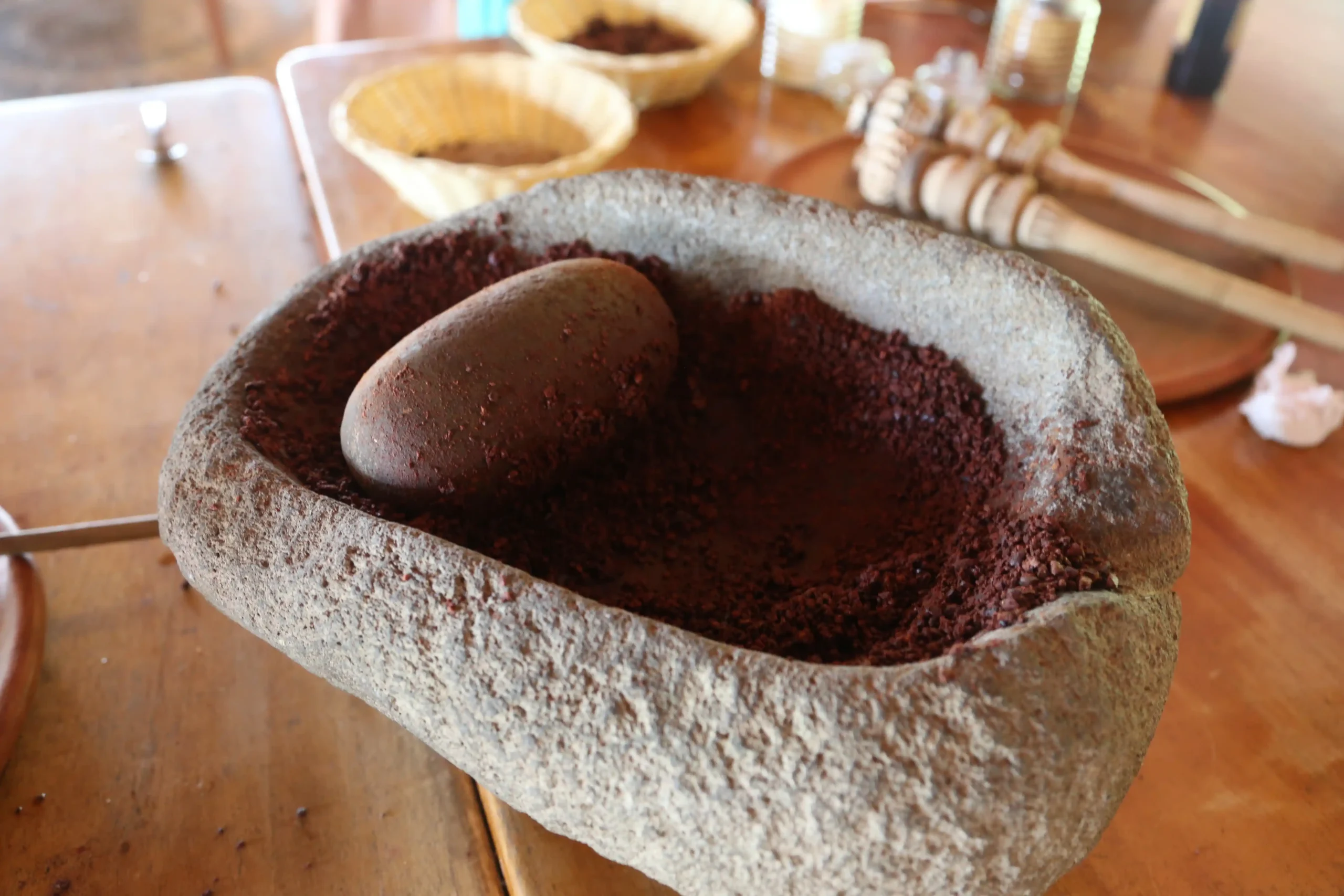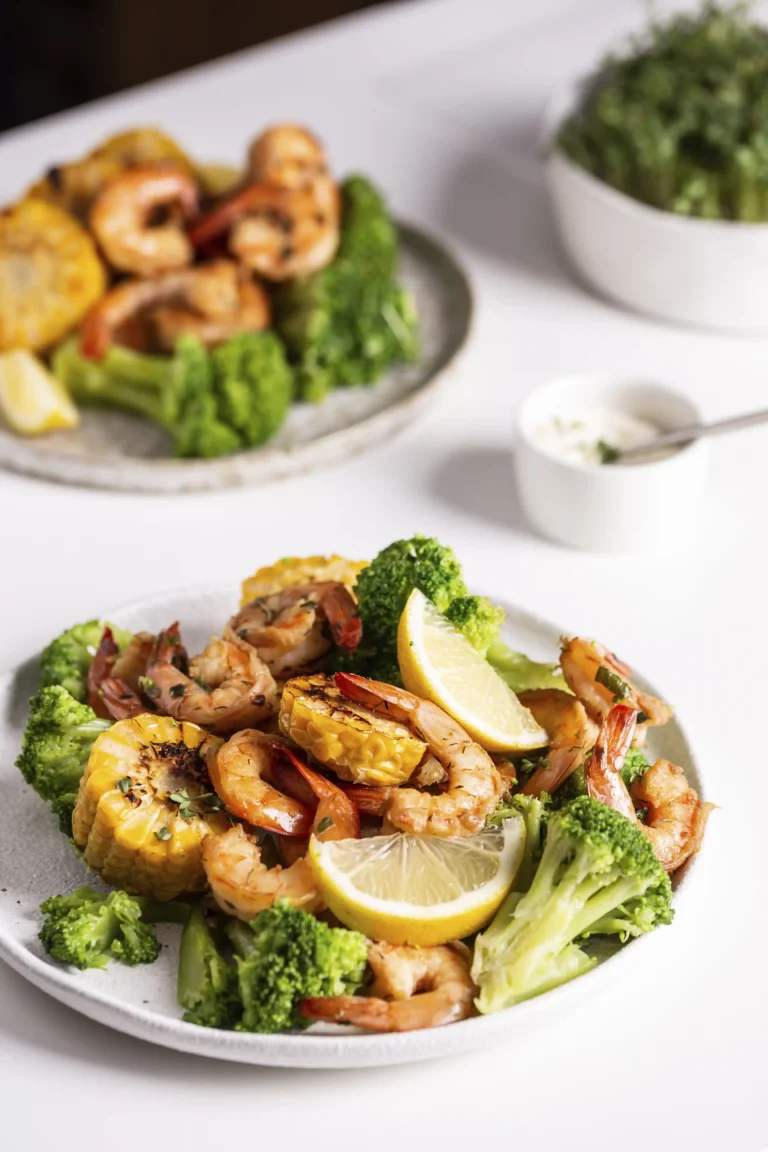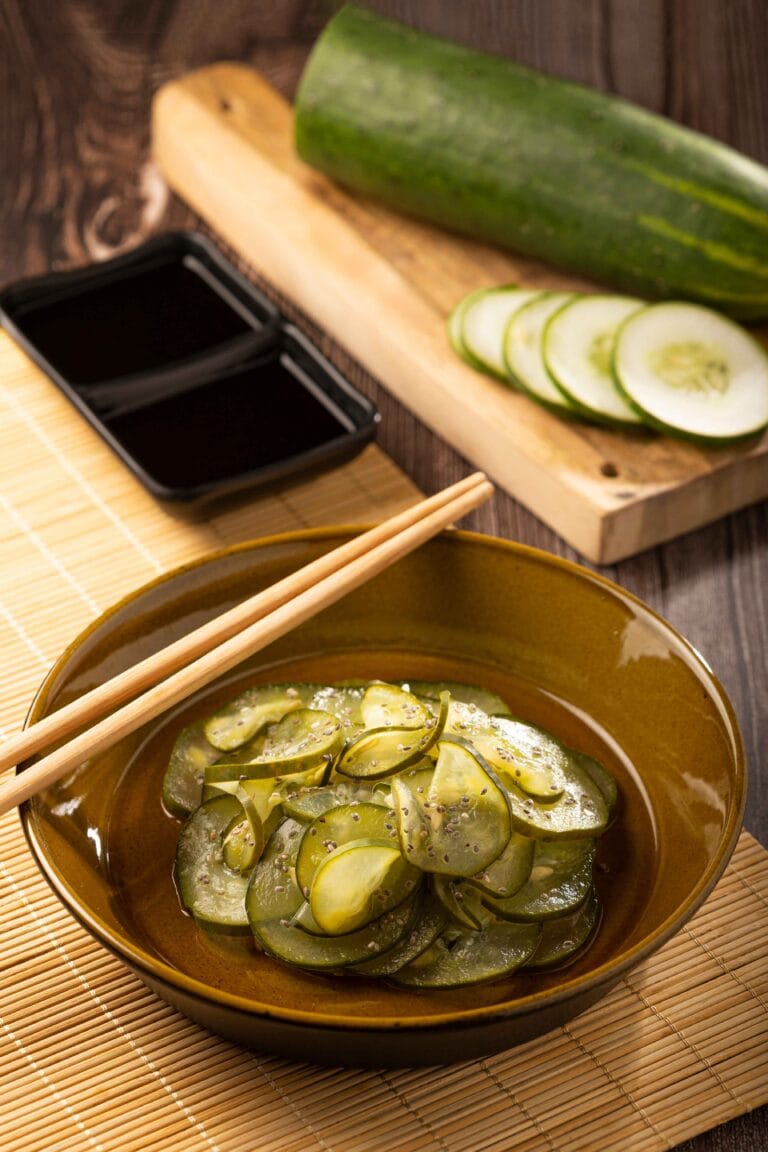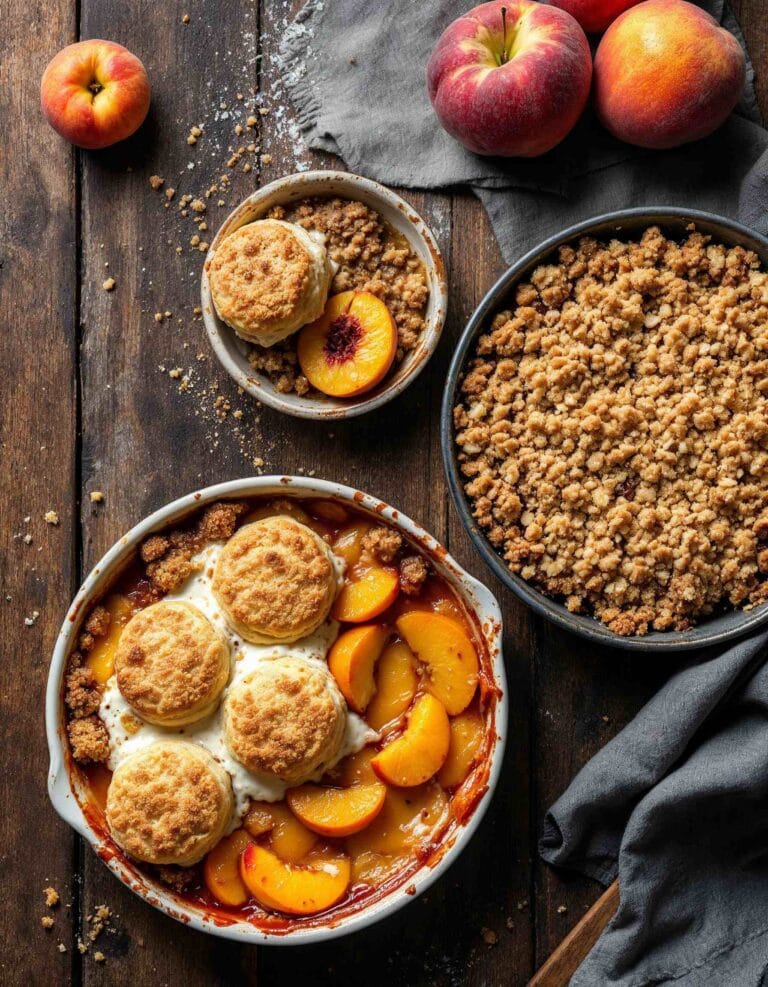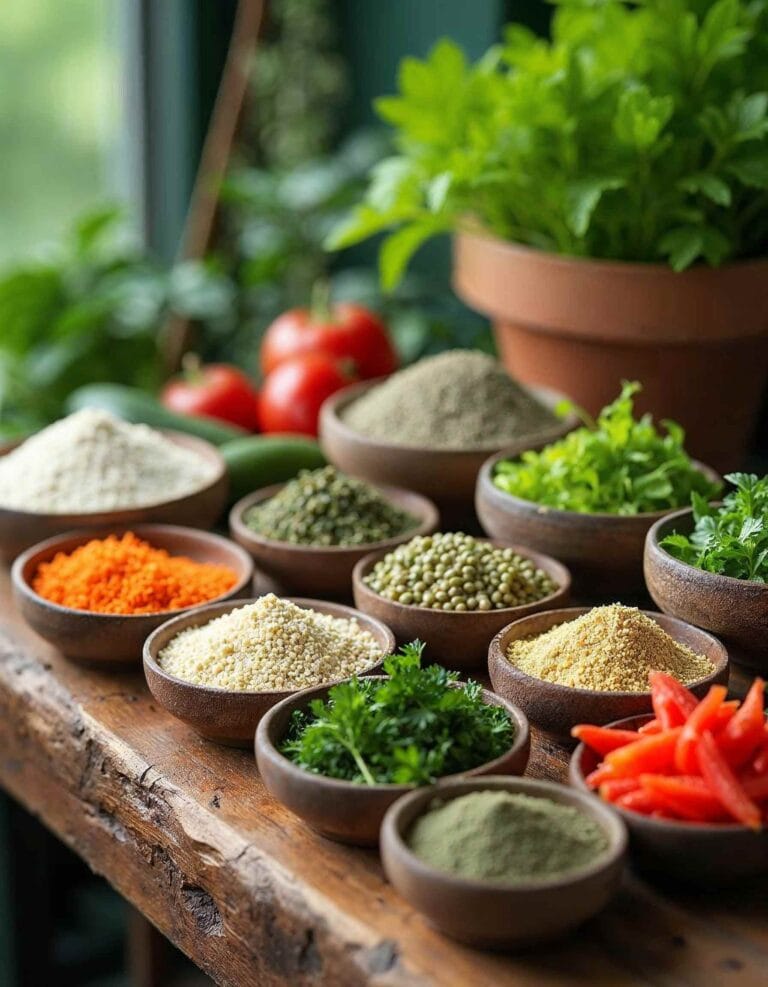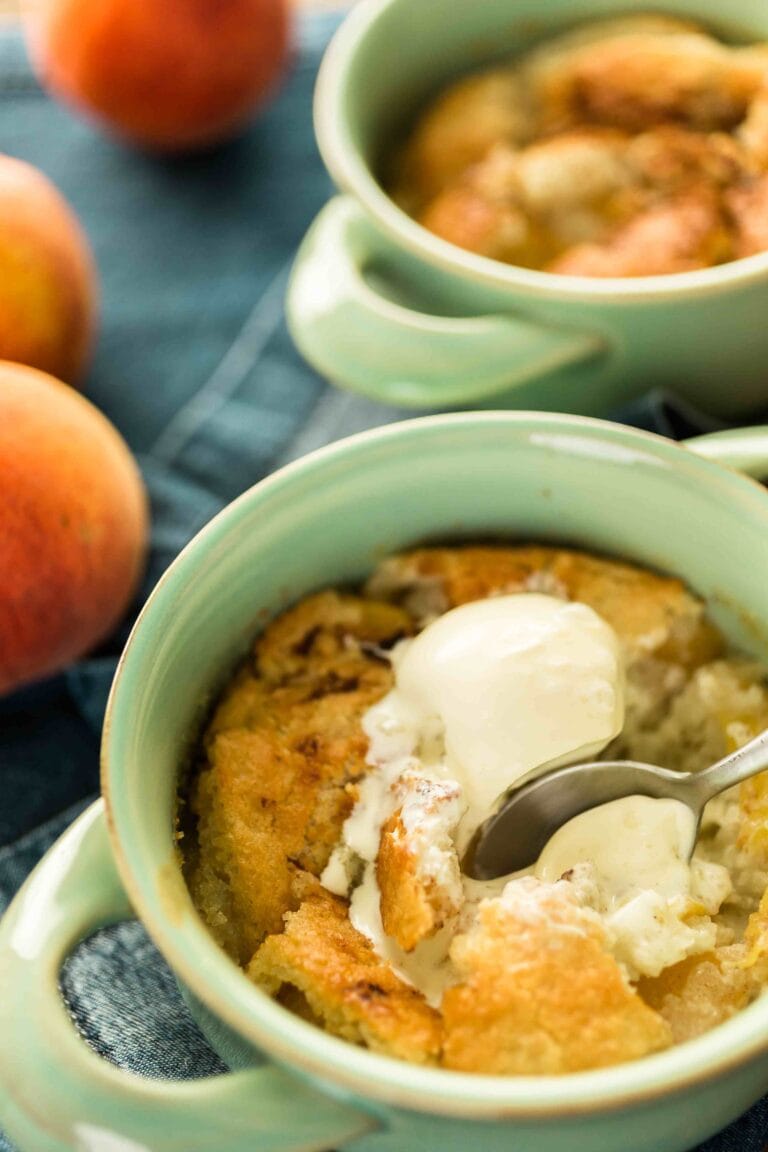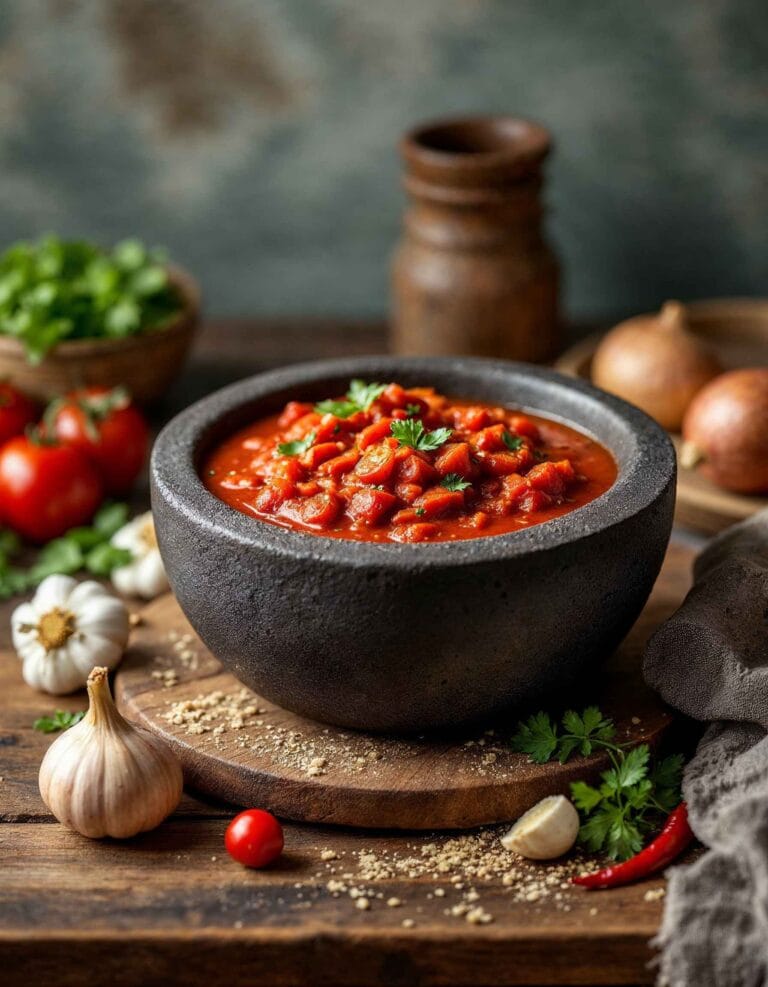What is a Traditional Molcajete Made Of? Discover Its Authentic Material and Unique Benefits
The molcajete, a traditional Mexican mortar and pestle, is a cherished symbol of culinary artistry and cultural heritage. Used for grinding spices, blending salsas, and creating flavorful pastes, the molcajete has been a cornerstone of Mexican cuisine for centuries. Beyond its practical uses, the tool carries deep cultural significance, representing a link to ancient cooking traditions that date back to the Aztecs and Mayans.
At the heart of the molcajete’s effectiveness is the material it is made of. Traditionally, molcajetes are crafted from volcanic basalt stone, a choice that has been carefully maintained for its unique properties. This material not only makes the tool incredibly durable but also enhances its ability to grind ingredients into fine, even textures, unlocking their full flavors and aromas.
In this article, we’ll explore the material composition of traditional molcajetes, the craftsmanship involved in their creation, and their functional benefits. Additionally, we’ll discuss how to maintain them, identify authentic ones, and answer common questions about this iconic kitchen tool.
Discover step-by-step instructions for preparing a molcajete-based recipe.
Core Material
Volcanic Basalt Stone
The traditional molcajete is made from volcanic basalt stone, a material that has been used for centuries due to its remarkable properties. This natural volcanic rock is formed from the cooling of lava and is known for its rough, porous texture, which makes it ideal for grinding and blending ingredients. Unlike smooth surfaces that might slip or fail to break down tougher items, basalt’s porous nature provides the friction necessary to crush even the hardest seeds and spices.
Volcanic basalt stone is not just chosen for its utility but also for its symbolic importance. In Mexican culture, it represents a connection to the earth and the ancient practices of cooking and food preparation. Artisans hand-carve this stone into the characteristic bowl and pestle shapes, creating a durable tool that is as functional as it is beautiful.
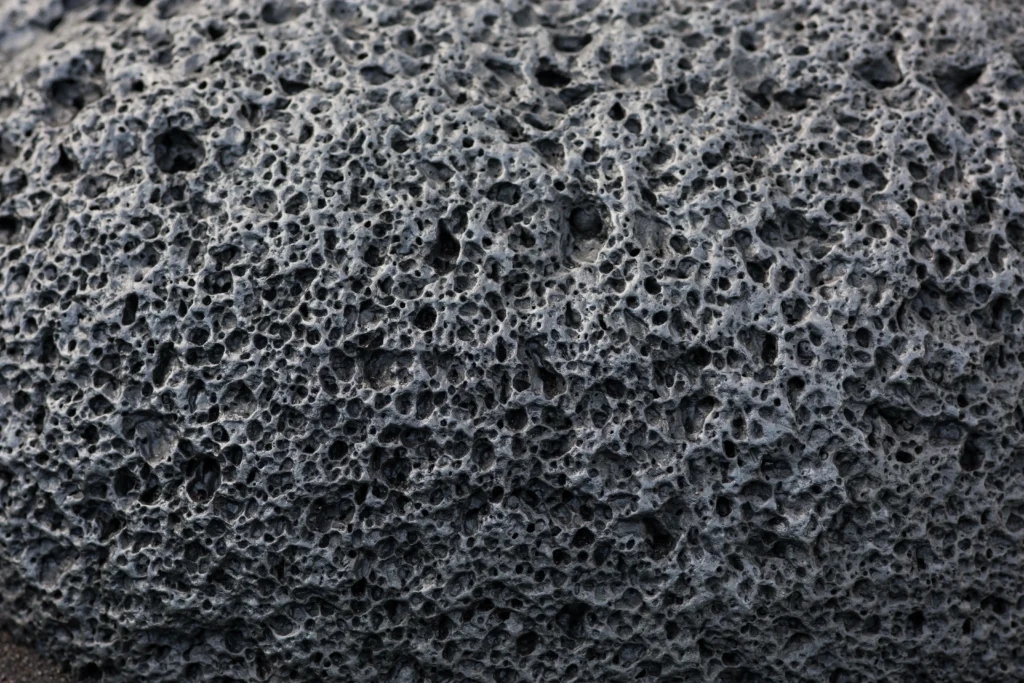
Why Basalt is Used
Several properties of volcanic basalt make it the preferred material for molcajetes:
- Porous Texture for Effective Grinding:
The porous surface of basalt allows it to grip and crush ingredients effectively. Unlike smooth materials such as ceramic or polished stone, basalt excels at grinding tough and fibrous ingredients like dried chiles, peppercorns, and garlic. - Durability:
Volcanic basalt is extremely hard and can withstand years of use without chipping or cracking. This makes a basalt molcajete a long-lasting investment for any kitchen. - Flavor Enhancement:
The porous stone surface can retain small amounts of ground spices and oils, enhancing the flavors of future recipes. This characteristic, often compared to seasoning a cast iron skillet, gives traditional molcajetes an edge over their modern counterparts. - Natural and Non-Toxic:
Unlike synthetic or chemically treated materials, volcanic basalt is a natural, non-toxic option for food preparation. This makes it a safe and eco-friendly choice for traditional cooking.
Modern Alternatives to Basalt
While basalt remains the gold standard for molcajetes, modern materials like granite, marble, or even synthetic composites have been used as alternatives. These materials may offer similar durability but often lack the porous surface that gives basalt molcajetes their unique grinding properties.
- Granite Molcajetes: While durable, granite’s smoother surface does not provide the same friction as basalt.
- Ceramic and Synthetic Options: These may be lighter and easier to clean but often fail to replicate the texture and functionality of volcanic stone.
Traditional molcajetes made of volcanic basalt continue to be favored by chefs and home cooks who value authenticity, flavor, and the unmatched grinding experience it provides.
Explore common and creative ingredients for molcajete dishes.
Craftsmanship
How Molcajetes Are Made
Creating a traditional molcajete is an intricate process that involves both artistry and skill. Each molcajete is handcrafted by artisans who use time-honored techniques passed down through generations.
- Sourcing the Basalt Stone:
Artisans begin by selecting volcanic basalt stone from regions known for their high-quality deposits. The stone is carefully chosen for its texture and durability, ensuring it is free from cracks or flaws that could compromise its functionality. - Carving the Shape:
The artisan uses tools like chisels and hammers to carve the rough shape of the bowl and pestle. This step requires precision, as the molcajete’s structure must balance form and functionality. The bowl must be deep enough to contain ingredients while allowing for effective grinding. - Sculpting the Details:
After the basic shape is formed, the finer details are added. The interior of the bowl is roughened to enhance its grinding surface, while the exterior may be decorated with traditional motifs, such as animal shapes (like jaguars or turtles) that add cultural significance. - Final Inspection and Polishing:
Once the carving is complete, the molcajete undergoes a final inspection. While the grinding surface remains rough, the exterior is often polished to make it visually appealing and smooth to the touch.
Traditional vs. Modern Materials
With the rise of mass production, many molcajetes are now made using alternative materials or machine fabrication. However, there are significant differences between traditional basalt molcajetes and their modern counterparts.
- Handcrafted Basalt Molcajetes:
- Made from authentic volcanic stone.
- Unique due to individual hand-carving, ensuring no two pieces are identical.
- Culturally significant, supporting local artisans and traditional craftsmanship.
- Machine-Made or Non-Basalt Molcajetes:
- Often made from synthetic materials or granite, which lacks the porous texture of basalt.
- Produced in bulk, leading to uniform designs but reduced authenticity.
- Less effective in grinding ingredients due to smoother surfaces.
The Importance of Supporting Artisans
Purchasing a traditional molcajete not only ensures a high-quality kitchen tool but also supports the artisans who dedicate their craft to preserving this cultural heritage. By choosing authentic, handcrafted molcajetes, buyers contribute to the continuation of a tradition that connects modern kitchens to ancient culinary practices.
A detailed look into the core ingredients and preparation techniques.
Functionality
Impact of Material on Grinding
The functionality of a molcajete heavily depends on its material, particularly the volcanic basalt stone traditionally used. The porous surface of basalt provides the right amount of friction, making it easier to break down tough ingredients into smooth pastes or fine powders.
- Efficient Grinding:
The rough texture of the basalt surface grips ingredients, allowing for consistent grinding without slipping. This feature is particularly useful for breaking down fibrous materials like dried chiles, seeds, and herbs. - Even Texture and Flavor Release:
As ingredients are ground, their natural oils and flavors are released and evenly distributed. This process enhances the taste and aroma of recipes, such as salsas, guacamole, and spice blends. - Versatility:
A molcajete is not limited to Mexican cuisine. Its design is versatile enough to be used for preparing a wide variety of dishes, from Thai curry pastes to Mediterranean pestos, showcasing its adaptability across culinary styles.
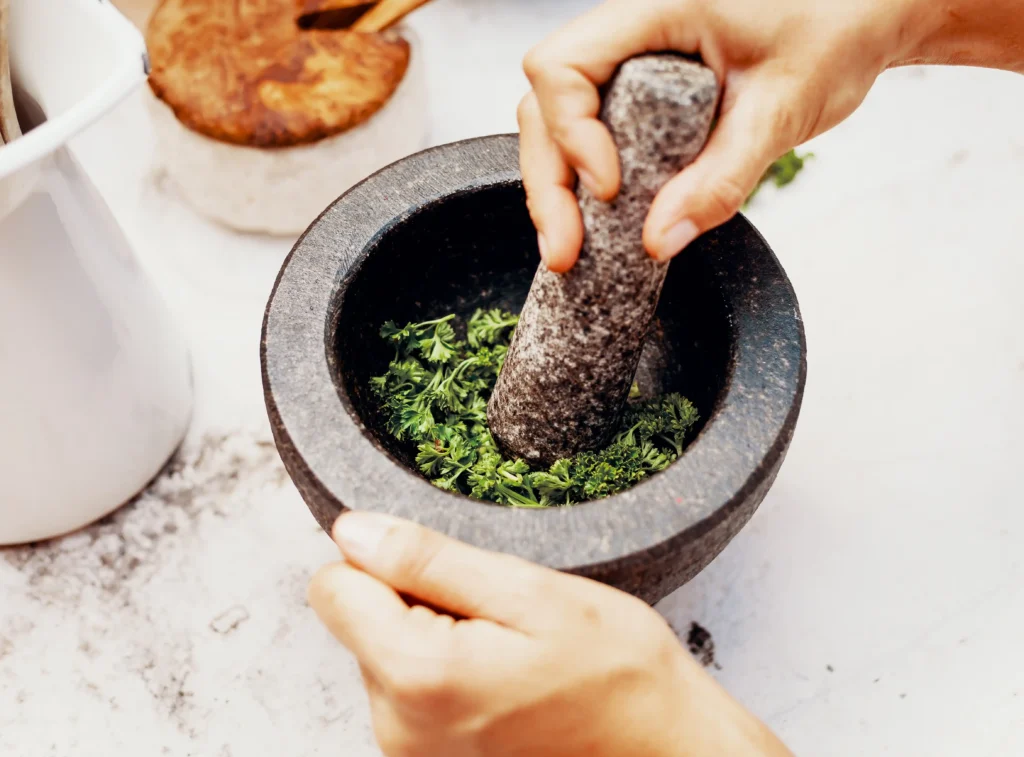
Retains Flavors and Aromas
One of the standout features of a basalt molcajete is its ability to retain and amplify flavors. The porous surface naturally absorbs small amounts of oils and seasonings, creating a “seasoned” effect over time.
- Enhancing Recipes: As the molcajete becomes seasoned, it subtly infuses the flavors of past uses into new dishes, adding depth and complexity.
- Authenticity in Taste: This seasoning process is especially valuable for traditional Mexican recipes, as it helps achieve the authentic flavors expected in regional dishes.
Advantages Over Modern Alternatives
While other materials like granite, ceramic, or synthetic options are available, they often fall short in replicating the functionality of a basalt molcajete.
- Granite: Though durable, granite’s smoother surface lacks the friction needed for efficient grinding, often requiring more effort.
- Ceramic or Synthetic Materials: These options are non-porous and can’t retain flavors, diminishing the seasoning effect that basalt offers.
- Mechanical Alternatives: Food processors and blenders can break down ingredients but fail to replicate the texture and consistency achieved with a molcajete.
A Cultural Experience
Using a molcajete goes beyond functionality; it is an immersive experience that connects the cook to traditional practices. The tactile process of grinding ingredients manually is both meditative and rewarding, allowing cooks to engage with their food in a meaningful way.
Maintenance
Curing a Molcajete
Before using a traditional basalt molcajete for the first time, it must be cured to remove stone debris and prepare its surface for grinding. This essential step ensures the molcajete is clean and ready for culinary use.
- Why Curing is Important:
- Removes tiny stone particles from the porous surface.
- Prepares the grinding surface by smoothing it slightly while retaining its rough texture.
- Prevents unwanted grit from mixing into food.
- Step-by-Step Curing Process:
- Wash Thoroughly: Rinse the molcajete and pestle under running water, scrubbing with a stiff brush to remove loose debris. Avoid using soap, as it may linger in the stone’s pores.
- Grind Dry Rice: Add a handful of uncooked rice to the bowl and grind it with the pestle in circular motions. This process helps smooth the interior and loosen any remaining particles. Repeat until the rice turns from gray to white.
- Rinse and Repeat: Rinse the molcajete again and repeat the grinding process with rice if necessary.
- Test with Ingredients: Once cured, test the molcajete by grinding salt or garlic to ensure no grit remains.
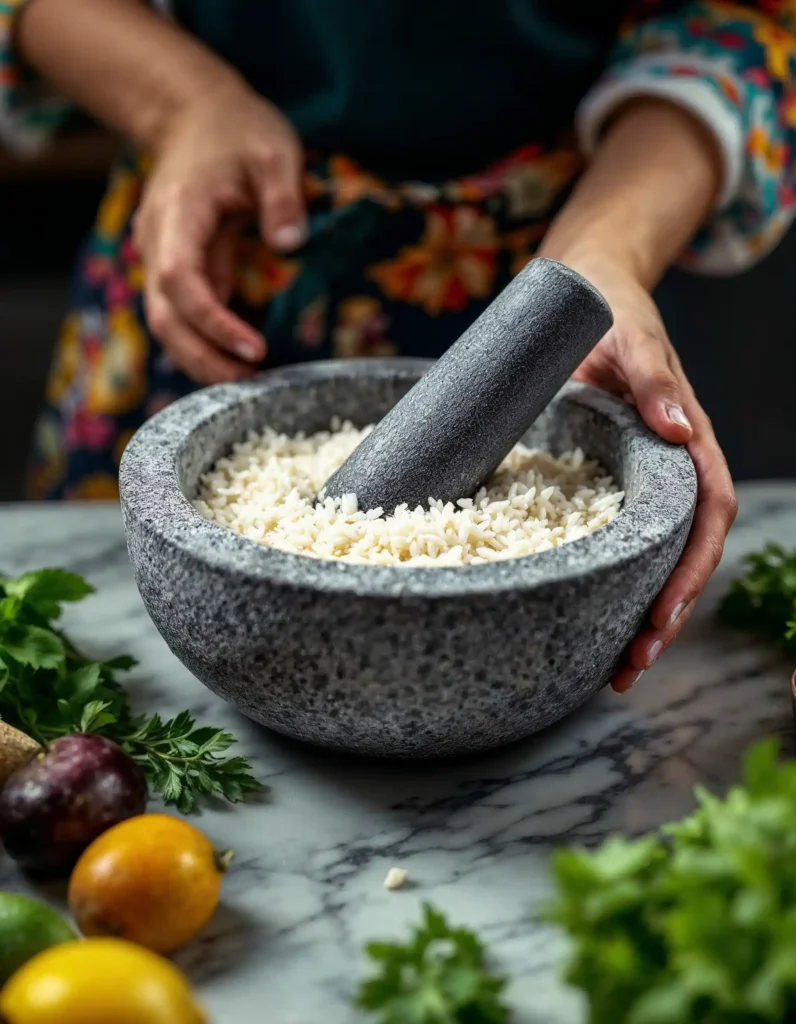
Step-by-step instructions for preparing and seasoning a molcajete.
Cleaning and Upkeep
Proper maintenance of a molcajete preserves its functionality and ensures it lasts for generations.
- Cleaning After Use:
- Avoid Soap: Use only warm water and a brush to clean the molcajete. The porous surface can absorb soap, which may alter the flavor of future dishes.
- Dry Completely: Allow the molcajete to air dry completely after washing to prevent mold or mildew in its porous surface.
- Dealing with Stubborn Residue:
- For sticky or hard-to-remove residue, grind coarse salt or a mixture of salt and water to scrub the surface naturally.
- Avoid abrasive cleaning products that could damage the stone.
- Periodic Maintenance:
- Over time, the molcajete may benefit from a re-curing process, especially if it has been unused for a long period.
- Check for cracks or chips, as damaged areas may harbor bacteria or compromise its effectiveness.
Long-Term Care Tips
- Storage: Keep the molcajete in a dry area to prevent moisture from weakening the stone.
- Seasoning: Regular use naturally seasons the molcajete, enhancing its ability to add depth of flavor to recipes.
- Avoid Extreme Temperatures: Do not expose the molcajete to sudden temperature changes, such as placing a cold molcajete into a hot oven or vice versa, as this can cause cracking.
Proper maintenance ensures that your molcajete remains a reliable and treasured tool for years to come, making it a lasting connection to traditional cooking methods.
Benefits of Basalt
Health Benefits of Using Natural Stone
Using a traditional molcajete made from volcanic basalt offers numerous health and safety advantages over modern alternatives.
- Non-Toxic Material:
Volcanic basalt is a completely natural material, free from synthetic chemicals or coatings that could leach into food. This ensures the safety of your ingredients during grinding and preparation. - Adds Minerals:
Basalt contains trace amounts of natural minerals that may be released in minuscule quantities during use. These minerals, such as iron and calcium, can enhance the nutritional value of your food. - No Artificial Residues:
Unlike plastic or synthetic materials, basalt does not impart artificial tastes, smells, or residues into food, preserving the integrity of the flavors.
Longevity and Sustainability
Molcajetes made from volcanic basalt are celebrated for their durability and eco-friendliness.
- Exceptional Longevity:
Basalt molcajetes are designed to last for decades, often being passed down through generations. The hardness of volcanic stone ensures it resists wear and tear even with frequent use. - Sustainability:
- The hand-carving process used to create traditional molcajetes has a minimal environmental impact compared to machine-made alternatives.
- The use of natural stone means the product is biodegradable and does not contribute to long-term waste.
- Cost-Effectiveness:
Though an authentic basalt molcajete may have a higher initial cost, its longevity makes it a worthwhile investment. It eliminates the need for frequent replacements, saving money and reducing consumption.
Enhancing Culinary Experiences
The benefits of basalt extend beyond its practical and environmental advantages.
- Superior Grinding Ability:
The porous texture of basalt makes it ideal for grinding tough ingredients into fine powders or smooth pastes, creating a culinary experience that mechanical grinders or smooth-surfaced alternatives can’t replicate. - Flavor Enrichment:
The seasoning effect of a basalt molcajete elevates the flavor profile of dishes over time. Its ability to retain and distribute natural oils and spices results in richer and more authentic tastes. - Aesthetic and Cultural Value:
A basalt molcajete is not just a tool but a piece of functional art. Its handcrafted nature and traditional design add character to any kitchen, while its historical roots provide a connection to Mexican culinary traditions.
Versatility in Use
From grinding dried spices to preparing fresh salsas, a basalt molcajete is incredibly versatile. Its durability allows it to handle a wide range of ingredients and techniques, making it a staple for home cooks and professional chefs alike.
FAQs
What is a real molcajete made of?
A real molcajete is traditionally made from volcanic basalt stone, a type of porous rock formed from cooled lava. This material is favored for its rough texture, which provides natural friction for grinding and blending ingredients. Authentic molcajetes are handcrafted by artisans who carve them from single pieces of basalt, ensuring durability and effectiveness.
What is the best material for a molcajete?
The best material for a molcajete is volcanic basalt stone. Its porous surface grips and crushes ingredients efficiently, making it superior to alternatives like granite or ceramic. Basalt is also naturally non-toxic, durable, and contributes to the seasoning effect, enhancing the flavors of food over time. While modern molcajetes may use materials like granite or synthetic composites, these often lack the functionality and authenticity of traditional basalt.
How to tell if your molcajete is authentic?
To determine if your molcajete is authentic, consider the following factors:
- Material: Genuine molcajetes are made from volcanic basalt. You can test authenticity by lightly scraping the surface. Real basalt produces a slightly gritty residue, whereas synthetic materials do not.
- Weight: Authentic molcajetes are heavy due to the density of basalt stone. Lightweight models are likely made from imitations like resin or other synthetic materials.
- Handcrafted Details: Look for imperfections or unique marks, as true molcajetes are hand-carved and not machine-made.
- Sound Test: Tap the molcajete lightly with a metal utensil. Authentic basalt produces a dull sound, while synthetic or ceramic ones may sound hollow or sharp.
What is the difference between volcanic and granite molcajete?
The main differences between volcanic and granite molcajetes lie in their texture, functionality, and authenticity:
- Texture:
- Volcanic Basalt: Porous and rough, providing superior friction for grinding.
- Granite: Smoother, making it less effective for crushing tough ingredients.
- Flavor and Aroma:
- Volcanic Basalt: Retains and enhances flavors over time due to its porous nature.
- Granite: Does not absorb or enhance flavors, offering a neutral surface.
- Weight and Durability:
- Volcanic Basalt: Slightly lighter and more durable due to its natural composition.
- Granite: Heavier and more prone to cracking under extreme pressure.
- Authenticity:
- Volcanic basalt is the traditional and culturally significant material used in authentic molcajetes, while granite is often a modern alternative.
Conclusion
The traditional molcajete is more than just a tool—it is a testament to the artistry and culinary traditions of Mexico. Handcrafted from volcanic basalt stone, authentic molcajetes offer unmatched functionality, durability, and flavor-enhancing properties that modern alternatives simply cannot replicate.
The porous surface of basalt makes it ideal for grinding, allowing cooks to unlock the full potential of their ingredients while retaining natural oils and aromas. Over time, a well-maintained molcajete becomes a seasoned companion in the kitchen, contributing to richer and more authentic flavors. Moreover, its longevity and natural composition make it a sustainable and eco-friendly choice for any kitchen.
Choosing an authentic molcajete not only supports traditional craftsmanship but also connects you to centuries-old cooking practices that celebrate flavor, culture, and community. Whether you’re crafting a classic salsa or experimenting with global cuisines, the molcajete remains an indispensable tool for any passionate cook.

